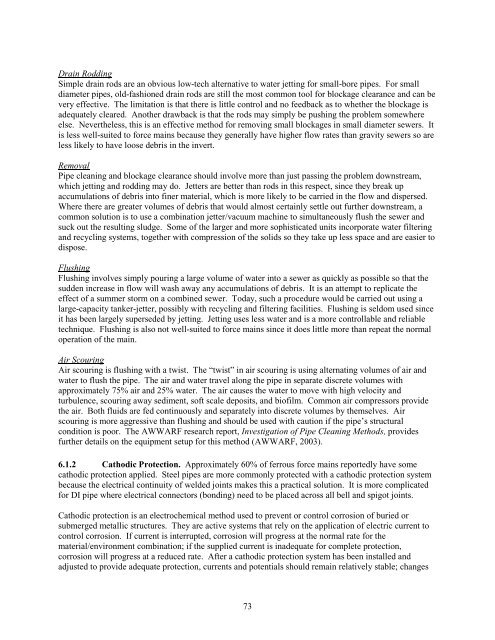State of Technology Report for Force Main Rehabilitation, Final ...
State of Technology Report for Force Main Rehabilitation, Final ...
State of Technology Report for Force Main Rehabilitation, Final ...
Create successful ePaper yourself
Turn your PDF publications into a flip-book with our unique Google optimized e-Paper software.
Drain Rodding<br />
Simple drain rods are an obvious low-tech alternative to water jetting <strong>for</strong> small-bore pipes. For small<br />
diameter pipes, old-fashioned drain rods are still the most common tool <strong>for</strong> blockage clearance and can be<br />
very effective. The limitation is that there is little control and no feedback as to whether the blockage is<br />
adequately cleared. Another drawback is that the rods may simply be pushing the problem somewhere<br />
else. Nevertheless, this is an effective method <strong>for</strong> removing small blockages in small diameter sewers. It<br />
is less well-suited to <strong>for</strong>ce mains because they generally have higher flow rates than gravity sewers so are<br />
less likely to have loose debris in the invert.<br />
Removal<br />
Pipe cleaning and blockage clearance should involve more than just passing the problem downstream,<br />
which jetting and rodding may do. Jetters are better than rods in this respect, since they break up<br />
accumulations <strong>of</strong> debris into finer material, which is more likely to be carried in the flow and dispersed.<br />
Where there are greater volumes <strong>of</strong> debris that would almost certainly settle out further downstream, a<br />
common solution is to use a combination jetter/vacuum machine to simultaneously flush the sewer and<br />
suck out the resulting sludge. Some <strong>of</strong> the larger and more sophisticated units incorporate water filtering<br />
and recycling systems, together with compression <strong>of</strong> the solids so they take up less space and are easier to<br />
dispose.<br />
Flushing<br />
Flushing involves simply pouring a large volume <strong>of</strong> water into a sewer as quickly as possible so that the<br />
sudden increase in flow will wash away any accumulations <strong>of</strong> debris. It is an attempt to replicate the<br />
effect <strong>of</strong> a summer storm on a combined sewer. Today, such a procedure would be carried out using a<br />
large-capacity tanker-jetter, possibly with recycling and filtering facilities. Flushing is seldom used since<br />
it has been largely superseded by jetting. Jetting uses less water and is a more controllable and reliable<br />
technique. Flushing is also not well-suited to <strong>for</strong>ce mains since it does little more than repeat the normal<br />
operation <strong>of</strong> the main.<br />
Air Scouring<br />
Air scouring is flushing with a twist. The “twist” in air scouring is using alternating volumes <strong>of</strong> air and<br />
water to flush the pipe. The air and water travel along the pipe in separate discrete volumes with<br />
approximately 75% air and 25% water. The air causes the water to move with high velocity and<br />
turbulence, scouring away sediment, s<strong>of</strong>t scale deposits, and bi<strong>of</strong>ilm. Common air compressors provide<br />
the air. Both fluids are fed continuously and separately into discrete volumes by themselves. Air<br />
scouring is more aggressive than flushing and should be used with caution if the pipe’s structural<br />
condition is poor. The AWWARF research report, Investigation <strong>of</strong> Pipe Cleaning Methods, provides<br />
further details on the equipment setup <strong>for</strong> this method (AWWARF, 2003).<br />
6.1.2 Cathodic Protection. Approximately 60% <strong>of</strong> ferrous <strong>for</strong>ce mains reportedly have some<br />
cathodic protection applied. Steel pipes are more commonly protected with a cathodic protection system<br />
because the electrical continuity <strong>of</strong> welded joints makes this a practical solution. It is more complicated<br />
<strong>for</strong> DI pipe where electrical connectors (bonding) need to be placed across all bell and spigot joints.<br />
Cathodic protection is an electrochemical method used to prevent or control corrosion <strong>of</strong> buried or<br />
submerged metallic structures. They are active systems that rely on the application <strong>of</strong> electric current to<br />
control corrosion. If current is interrupted, corrosion will progress at the normal rate <strong>for</strong> the<br />
material/environment combination; if the supplied current is inadequate <strong>for</strong> complete protection,<br />
corrosion will progress at a reduced rate. After a cathodic protection system has been installed and<br />
adjusted to provide adequate protection, currents and potentials should remain relatively stable; changes<br />
73















